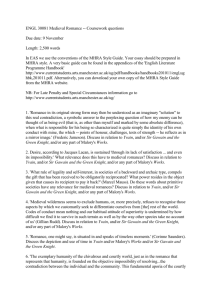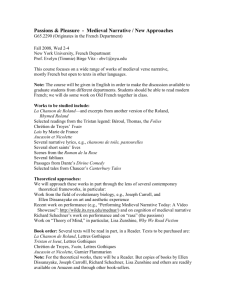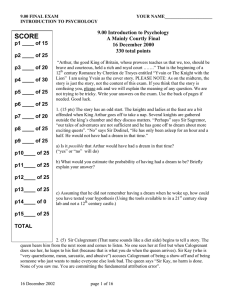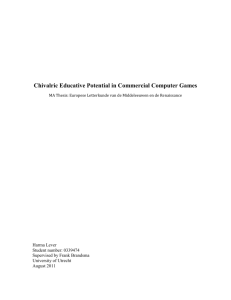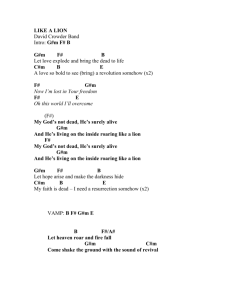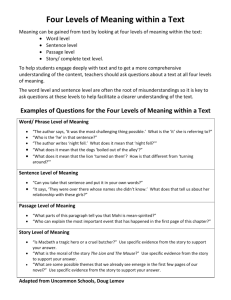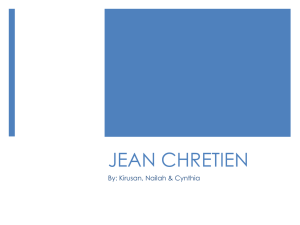Yvain - WordPress.com
advertisement
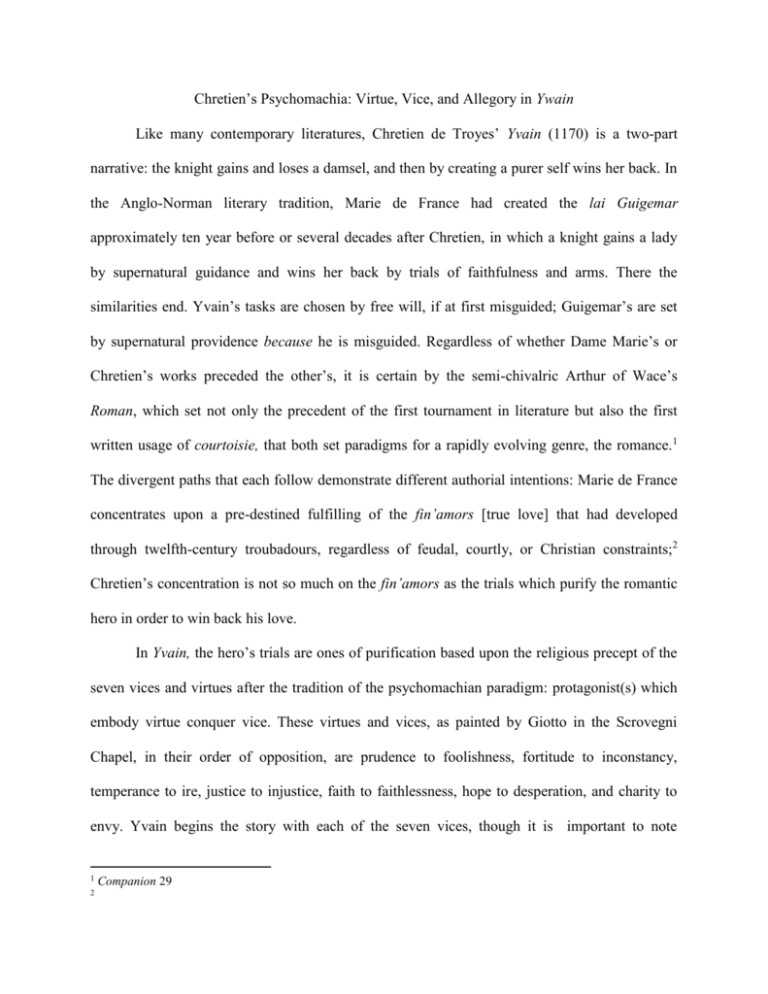
Chretien’s Psychomachia: Virtue, Vice, and Allegory in Ywain Like many contemporary literatures, Chretien de Troyes’ Yvain (1170) is a two-part narrative: the knight gains and loses a damsel, and then by creating a purer self wins her back. In the Anglo-Norman literary tradition, Marie de France had created the lai Guigemar approximately ten year before or several decades after Chretien, in which a knight gains a lady by supernatural guidance and wins her back by trials of faithfulness and arms. There the similarities end. Yvain’s tasks are chosen by free will, if at first misguided; Guigemar’s are set by supernatural providence because he is misguided. Regardless of whether Dame Marie’s or Chretien’s works preceded the other’s, it is certain by the semi-chivalric Arthur of Wace’s Roman, which set not only the precedent of the first tournament in literature but also the first written usage of courtoisie, that both set paradigms for a rapidly evolving genre, the romance.1 The divergent paths that each follow demonstrate different authorial intentions: Marie de France concentrates upon a pre-destined fulfilling of the fin’amors [true love] that had developed through twelfth-century troubadours, regardless of feudal, courtly, or Christian constraints;2 Chretien’s concentration is not so much on the fin’amors as the trials which purify the romantic hero in order to win back his love. In Yvain, the hero’s trials are ones of purification based upon the religious precept of the seven vices and virtues after the tradition of the psychomachian paradigm: protagonist(s) which embody virtue conquer vice. These virtues and vices, as painted by Giotto in the Scrovegni Chapel, in their order of opposition, are prudence to foolishness, fortitude to inconstancy, temperance to ire, justice to injustice, faith to faithlessness, hope to desperation, and charity to envy. Yvain begins the story with each of the seven vices, though it is important to note 1 2 Companion 29 Chretien nor the reader can ever truly condemn him. Rather, the good-intentioned Yvain falls into the traps of vice in the first movement of his story and resolves them and embodies their polar virtues through his seven trials: Yvain is foolish, or naive, when he pursues the quest of the fountain in his cousin’s stead; inconstant in his ability to keep his word to Laudine; angered at the provocations of Sir Kay; unjust in pursuing Esclados le Ros for his own vanity so as to have a token of victory; so desperate in his pursuit that he can hear the moans of his victim; envious, i.e. covetous, of Laudine, late wife of Esclados le Ros. These vices are, in effect, the sins that Yvain says for which he has endured many trials at the end of Yvain. The trials, then, are his punishment. However, the open acknowledgement of his actions in the first part of the narrative as sin and the trials as redemption is the conclusion of a much larger, allegorical construct that began his questing: the representation of Yvain as the fallen Adam cast out from the garden and set to do labor as penance. Laudine’s dismissal of Yvain casts him out of the medieval social order of knighthood, courtly life, and chivalry; Yvain has been neither of the latter two.3 He instead gives primacy to the violence of knighthood, denying charity and mercy in his pursuit of Esclados le Ros and courtly order in his failure to return to Laudine. Removed from his court and forced to confront his failings, a ‘storm’ goes through Yvain that turns him into a wild man. It is the same storm that erupts out of the fountain, a storm that disrupts all social order, calling out Esclados who 3 A full explanation of why Yvain does not enter into the courtly or chivalric order requires definitions of the two in regard to Chretien’s narrative. Yvain places courtly life in a system of economy: feudal contracts, promises, and blows dealt are spoken of in terms of losses and gains in term of specie: in reply to Yvain’s acclaim for Gawain’s prowess when they fight anonymously, Gawain says that whatever strength he has lent to Yvain, Yvain has paid him back with interest; Yvain ‘owes more than he can pay’ to Laudine, a debt not covered by his rescuing Lunete; the Lady of Noroison restores Yvain’s sanity through a balm that she commodifies both in her directions to her damsel and her grievance at its loss, while her payment is Yvain’s victory over her assailant. These are just a few notable examples. The chivalric order, on the other hand, is something internalized by the knight. It is largely a choice of free will defined by how a knight chooses outside of the commodified obligations of the choice, and is defined in terms of charity and mercy. Yvain grants no mercy to Esclados le Ros in the first part of the narrative, and Yvain and Esclados are honorable to each others steeds not for charity’s or mercy’s sake but to increase the prestige of their violence. Yvain removes and making the citizenry regret even their geographical location in its second summoning. It also, however, provides the opportunity for a newer and more harmonious order to emerge when the storm has settled with the sanction of God: [‘But God gave me (Calogrenant) such comfort that the storm did not continue long, and all the winds died down again. The winds dared not blow against God’s will….As soon as the storm was completely past, I saw so many birds gathered in the pine tree...that not a brach or twig was to be seen which was not entirely covered with birds. The tree was all the more lovely then, for all the birds sang in harmony, yet the note of each one was different’.]4 The birds produce a beautiful harmony, Yvain is a better protector of the fountain the Esclados le Ros; his love is fin’amors; and the storm’s second summoning, this time by the Chevalier au Lion, sets the conditions for Yvain’s true return to the court. When the tempest sets upon Yvain’s mind, then, the same paradigm applies: order is disrupted—he becomes naked—and through God’s grace he is set upon punishment that, if pursued, will earn him redemption or, in biblical contexts, salvation, and, in Chretien’s words, pes, Yvain’s trial-earned pardon from Laudine.5 Before Yvain can experience the sanction of God, he must take the first step toward renewing his place in the medieval social order. Rather than being allegorical, this is a medieval pre-requisite Chretien employs before Yvain can possibly be recreated as Adam. To here the word of God through mass, first you have to be sane—that is, Yvain has to re-enter a feudal contract. The gesture Yvain employs is simple and, as all court interactions are economical in Yvain, one of commodity: he ‘trades’ wild game for bread and water with a hermit. The hermit cleans the game, sells the hides, and buys better bread which then returns to the crazed Yvain, and—most importantly—prays to God to defend against Yvain’s madness. The change between the wild Yvain and the damsel is immediately, almost ridiculously, manifested; the same 4 5 Arthurian Romances, 186 Companion, 165 sentence that begins with Yvain being content with his barter economy ends with him being found by the Lady of Noroison—the court comes to him: [So, after that, Yvain had a plentiful supply of bread and venison, which sufficed him for a long time, until one day he was found asleep in the forest by two damsels and their mistress in whose service they were.]6 The lady proposes to heal Yvain with a balm from Morgan le Sage (Morgan le Fay?), her damsel does so in her stead, and places a robe next to his body, which the sane, awakened Yvain dons. For context, the passage from the Bible that Chretien alludes to is Genesis 3:21-23. Adam and Eve have eaten from the tree of knowledge, have made garments from fig leaves, and have hidden from God. God finds them, reprimands them and the snake, clothes them, and casts them out of Eden: 21 And the LORD God made for Adam and his wife garments of skins and clothed them. 22 Then the LORD God said, ‘Behold, the man has become like one of us in knowing good and evil. Now, lest he reach out his hand and take also the tree of life and eat, and live forever—’ 23 therefore the LORD God sent him out from the garden of Eden to work the ground from which he was taken. Allegorically, the court takes the place of God in the encounter. The court finds Yvain just as God finds Adam and Eve. God and the damsel have to discover the nature of the encounter by physical markers: the Lord’s ‘“Who told you that you were naked? Have you eaten of the tree’” to the damsel’s finding Yvain’s scar. Chretien’s change to the biblical scene, however, is to make chastisement and punishment a matter of free will. Yvain feels his own shame for his nakedness, though Adam does not at his second clothing. He puts the robe on himself. And, weakened, he asks the damsel for assistance, who then truly begins the second movement of the narrative by bringing him to his first task, his first chance to redeem himself at the behest of the woman who helped him recover—‘to work the ground from which he was taken.’ 6 Arthurian Romances, 217-8 It is the robe which holds the greatest significance in this passage of Yvain just as it is the ‘garments of skins’ which receive the greatest attention in this passage of Genesis. Biblically, clothing is the external manifestation of the fall of man, since man can no longer walk around in blissful nakedness without shame; at the same time, it is also protection against sin, since to be reminded of the fall of man is also to be forewarned of the repercussions of committing any act against the word of God. Following this logic, Yvain’s robe is the physical representation of his sin, and the badge that warns him against parting from the path of courtly and chivalric redemption. In kind, Yvain appears to have only one suit of armor throughout the second part of the poem, the one given to him by the Lady of Noroison. It is important, if disorderly, to make a final note on clothing in Yvain. He actually changes clothes twice in the latter part of the poem, once when he dons the damsel’s robe, and again at the behest of the court where he defeats the two devils and frees the sewing women. Chretien thus adds on to his previous biblical allusion and extends it to a message never made in the Bible. This, I believe, is because Chretien has become nearly infallible by time he takes another set of clothes. He is about to put the greatest amount of faith in God and the Right by allowing the lion to be imprisoned while he faces the ultimate enemy, demons. He commits his greatest act of charity when he frees the damsels. And he commits his chief act of fidelity when he refuses to take the hand of a girl described as one even Aphrodite would have a sex change and devote herself to. The symbolic third robe, then, anticipates a redeemed Yvain worthy of facing these obstacles. The providential nature of Yvain’s quests established, this allegorical interpretation opens the reader to the polarization between good and evil, vice to virtue, in the ensuing text. We’ve already seen that Yvain falls into the seven vices to varying degrees in the first part of of the poem. The tasks he begins reverse those vices to virtue, which Yvain then champions. He endures faithlessness in the forest, removed from society and thus from God. After leaving the forest, Yvain is often praying or being prayed for in fighting or in searching. He fulfills his obligation to the Lady of Noroison, justly restores order, charitably accepts Aliers’ surrender rather than running him down for the purpose of vainglory and violence as he did to Esclados le Ros, and with fidelity Yvain refuses to take the Lady of Noroison as his mistress. The battle against Aliers is Yvain’s first test since he was projected into biblical terms, and by it he earns God’s grace through the lion, an external representation of Yvain’s chivalry that comes when God is called upon, whose side against the dragon he chooses by free will, just as he chose to don the allegorical robe by his own choice.7 The lion reciprocates in the fashion of the court, his saved life is commodified, and in the rest of the poem the lion exhibits the virtues that Yvain championed in the fight against Aliers: justice to the wicked, humility to accept a human master, and charity to Yvain by sharing his labor. Yvain kills the giant Harpin of the Mountain, restoring justice and placing his faith in God that he can kill a superior enemy with the lion. He rescues Lunete, demonstrating the fortitude to carry through with his promises despite obstacles of giants and distance and a woman he is meant to marry. He champions God’s justice by defeating the demons, initially without the help of the lion, and choosing to remove the damsel-slaves over any material reward. In the end, Yvain’s ultimate task before his redemption is to fight for the younger sister of Noire Espine against Gawain. The virtues he has taken in are, by this point, fulfilled, though notably he feels hatred for his temporarily anonymous opponent. This seems to be detrimental to Yvain as a virtuous character, but Chretien makes certain to note that Yvain both hates and loves for an extended discussion of the lion as a manifestation of the will of God, see Julian Harris’s “The Role of the Lion in Chretien de Troyes’ Yvain.” 7 his opponent. The anger is directed at the anonymous opponent fighting against Chretien’s justice, while the love is for his friend Gawain. The moral dubiousness of the ensuing violence is what makes the lion, the divine hand and chivalric guide in Yvain, remain out of the fight in addition to the injustice of fighting with the lion against a singular and mundane opponent. Moral fallibility is settled through Yvain’s virtues when he shows humility and charity to his opponent, which then allows justice to take order through King Arthur. This is the final confirmation that Yvain is a changed man from the vice-ridden youth that began his quest to avenge Calogrenant. As such, the lion is relegated to a near non-existent role in the remainder of the poem, since there is no longer any need for God to intervene. Bibliography Published Primary Sources Chretien de Troyes. Arthurian Romances. Trans. by W.W. Comfort, ed. by Ernest Rhys. London: The Temple Press Letchworth, 1935. Published Secondary Sources A Companion to Chretien de Troyes. Ed. by Norris J. Lacy and Joan Tasker Grimbert. Cambridge, UK: Athenaeum Press Ltd, 2005 Baron, W.R.J. English Medieval Romance. New York: Longman Goup Limited, 1995. Calter, Paul. “Number Symbolism in the Middle Ages.” Dartmouth, 1998. <http://bit.ly/yhRwAi>. Davenport, Tony. Medieval Narrative: An Introduction. Oxford: Oxford University Press. 2004. Harris, Julian. “The Role of the Lion in Chretien de Troyes’ Yvain.” PMLA 64, no. 5 (Dec. 1949): 1143-1163. Menoca, Maria Rose. “Close Encounters in Medieval Provence: Spain’s Role in the Birth of Troubadour Poetry.” Hispanic Review 49, no. 1 (1981): 43-64.
